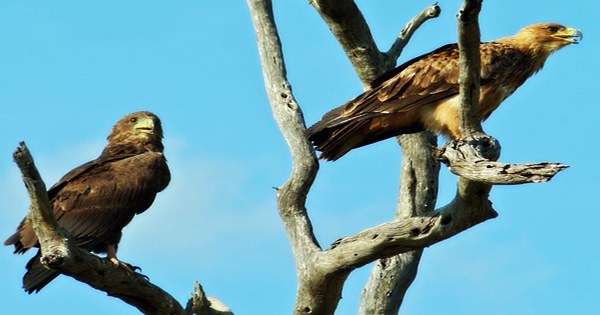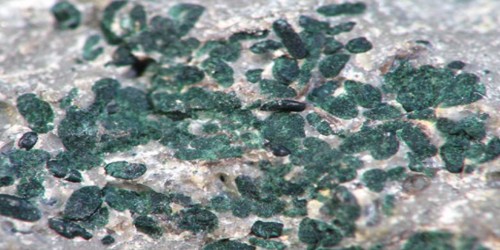The tawny eagle (Aquila rapax) is a large and attractive African bird of prey. It can be seen on both sides of the Sahara Desert, north and south. It is a member of the Accipitridae family, which includes all eagles. Its extensively feathered legs indicate that it belongs to the Aquilinae subfamily, popularly known as “booted eagles.” The Tawny Eagle was originally considered a relative of the Steppe Eagle (Aquila nipalensis), but due to changes in anatomy, particularly the length of the gape flange, which never reaches past the middle of the eye in the Tawny Eagle, it is now classified as its own species. The breeding range of these eagles is wide but irregular, encompassing much of the African continent as well as the Indian subcontinent, with uncommon residence in the southern Middle East. It prefers wide, arid habitats such as semideserts, deserts, steppes, and savanna plains across its range. Fresh carrion of all kinds makes up the majority of the Tawny Eagle’s diet, although it will also kill small animals up to the size of a rabbit, reptiles, and birds up to the size of guineafowl. It will also prey on other raptors for food. The tawny eagle is possibly the most opportunistic of all of its taxonomic kin, scavenging on carrion or engaging in kleptoparasitism towards other carnivorous animals while also being a bold and energetic predator of large and diverse food. It is estimated that tawny eagles can reach the age of 16 years old. Several factors, including deforestation and global warming, as well as persecution (often through poisoning) and other anthropogenic deaths (mostly through contact with various manmade items), are driving the once plentiful tawny eagles to the verge of extinction. Birds are significantly more efficient scavengers than mammals because they spot the carcasses first and can fly to the possible meal faster than an animal can run.

The tawny eagle is 65-72 cm (25.59 to 28.35 inches) long and weighs between 1.6 and 2.4 kg. It has a wide wingspan ranging from 1.72 to 1.85 meters (5.64 – 6.07 feet). Females are usually larger than males, although their look is comparable. The color of their plumage varies greatly, and these eagles can range from blonde to tawny brown. Meanwhile, the tail is either simple or darkly banded. The dark morph adult is primarily made up of dark, dull brown fur. With age, some dark morph tawny eagles may have uneven streaking, molting browns, and more blackish feathers. When they can, they scavenge and pirate, and when they can’t, they hunt. Because they are vulnerable to poisoned baits used in carnivore control, their scavenging tendencies have resulted in a reduction in their populations. The steppe and tawny eagles were separated due to morphological and anatomical differences. Despite some morphs of the two eagles loosely resembling one another, the steppe eagle is a larger bird with a considerably more obvious gape and differs by the appearance in its blockier frame, bigger wings, and evidence of different coloration at all stages of development. This Eagle has tawny upper parts with black flying feathers and tail, as well as a paler lower back area, as its name suggests. Its wings have bright colored stripes. Brown penetrating eyes and a yellow beak with a sharp, black, hooked tip distinguish the Tawny Eagle. Their feet are armed with enormous sharp talons and their legs are thickly feathered. Tawny Eagles have excellent eyesight, and hearing is a crucial sense for them because it helps them locate prey when hunting. The Tawny Eagle can be found in open or sparsely wooded areas, thornveld, and desert throughout Southern Africa, but not along Namibia’s coast. Doesn’t call out frequently but has a characteristic kow-kow call. This eagle is extremely lethargic, and instead of looking for prey, it hangs around with vultures and eats carrio. Birds, snakes, ground squirrels, dassies, and chameleons are the principal prey items while it hunts. It is a resident breeder that builds a stick nest in a tree, crag, or on the ground and deposits 1–3 eggs in it. The light rufous to pale tawny body of dark morph youngsters contrasts sharply with dark brown larger coverts, rear scapulars, flight feathers, and tail, all of which accentuate the creamy lower back to tail coverts. Dark morph juveniles can resemble pale morph adults, with the exception of trailing whitish borders and typically uneven pale diagonals along with the tips of greater wing coverts, which disappear quickly. Despite the fact that the steppe eagle is more sympatric with those northerly Eurasian eagles, genetically, the tawny eagle may cluster more closely with the imperial eagle species complex. Tawny Eagles are endothermic, meaning they absorb heat from the environment. These birds and mammals are homoiothermic, which means they have a consistent and generally high body temperature. Tawny Eagles, like other Eagle species, are diurnal, meaning they are active during the day and sleep at night. Tawny Eagles tend to stay in couples for many years, if not decades, in the same territory. Outside of the breeding season, these eagles are social, and flocks of 20 or more birds are typical. The species may be found outside of Africa in the southwestern section of the Arabian Peninsula, including in Yemen and extreme southwestern Saudi Arabia in the Tihamah and ‘Asir Regions, however, there have been few to no verified breeding occurrences in recent decades. Tawny Eagles are strong flyers, capable of flying at altitudes ranging from 600 to 2400 meters (1,968 to 14,760 feet). They only fly when air thermals let them soar, and they normally spend the day perched on a tree or telegraph pole scouring the ground for food. According to one study, the tawny eagle’s diet was the most evenly dispersed throughout all weight classes of prey, ranging from under 63 g (2.2 oz) to over 4 kg (8.8 lb), though it took somewhat less food in the latter prey class than the considerably bigger golden and wedge-tailed eagles (Aquila audax). The female Eagle lays one to three eggs in a stick and twig nest in the trees or on the ground. The male and female work together to build the nests. After 1 to 3 years, most nests are abandoned. The eggs hatch after the female has incubated them for 39 to 45 days. The male is occasionally responsible for incubation. The oldest Tawny Eagle ever reported in the wild was 60 years old.
















